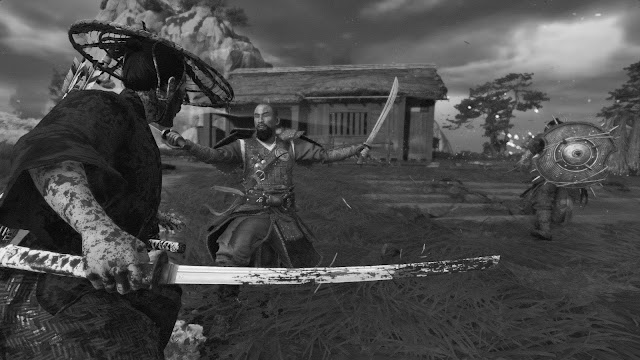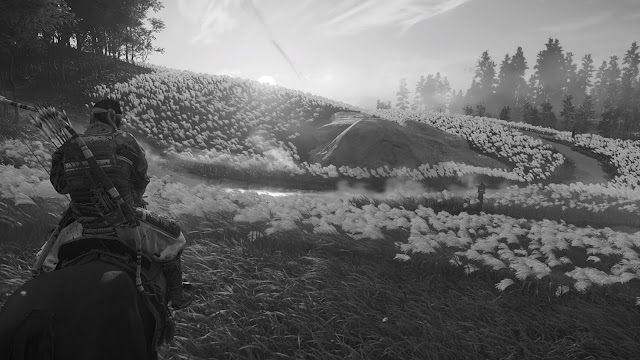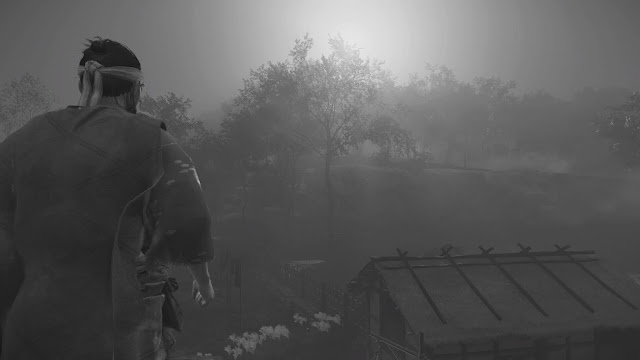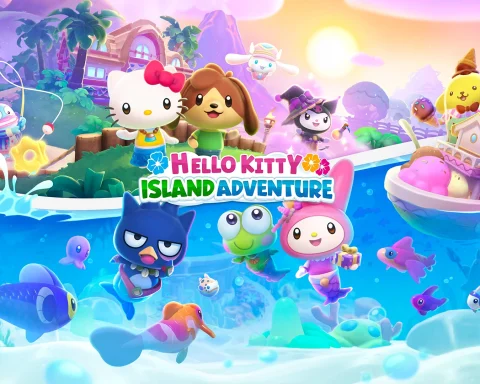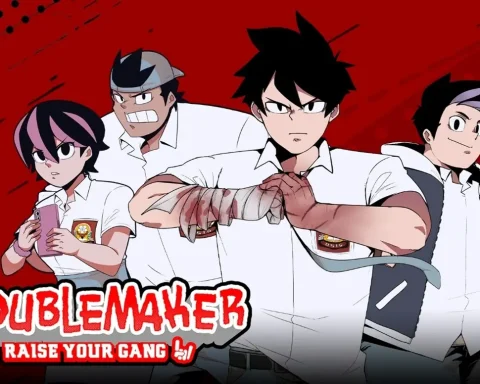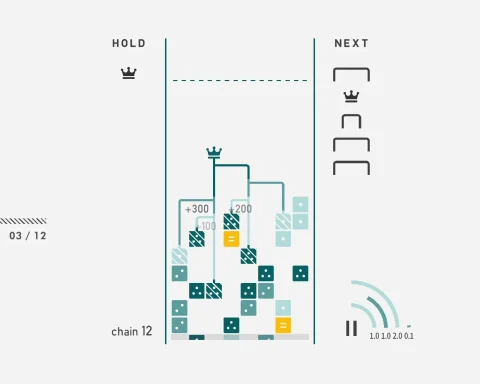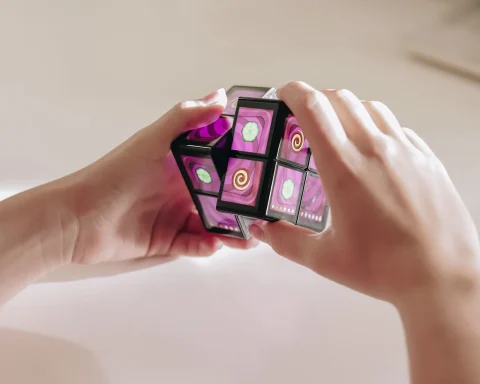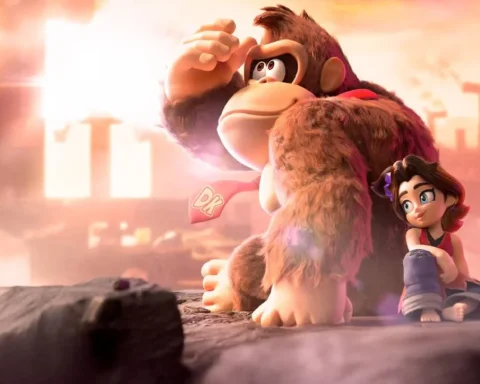Review by Matt S.
For a fraction of a second, I almost thought that developer, Sucker Punch, was going to surpass my expectations and deliver a game that genuinely understood and respected the samurai mythos. The opening moments of Ghost of Tsushima feature a small group of samurai facing down a Mongol armada, knowing that the impending wild charge to protect of their homeland was going to be to their deaths, but preparing to do it anyway.
One of their number goes down to the beach and issues a challenge to the Mongols’ greatest warrior. Expecting a fair fight, according to the samurai code, he’s killed through devious means. Now we know that the Mongols aren’t there to be honourable, flowery heroes (historically accurate enough), that the Japanese warriors, who after many generations of peace had turned the idea of combat into a neat set of rules and restrictions are not only hopelessly outnumbered by the pragmatic Mongol horde (also historically accurate), but are outmatched too, and in no way prepared for this kind of warfare.
For the fraction of Ghost of Tsushima that this opening scene occupies, it genuinely feels like Sucker Punch had done its research, understood the cultural context of Japanese samurai storytelling and the historical context of their game, and worked hard to put aside their own traditions and ideological understanding of storytelling as Americans in service of the foreign thing they were telling a story about.
Sadly, once that opening scene passes and Ghost of Tsushima starts in full, that initial positive impression falls face-first off a cliff. This game is, in its entirety, a dictation on what Japanese history and culture are allowed to be from a developer within a nation that has pulled this stunt far too often. American storytellers are far too comfortable with altering and re-writing other people’s histories and cultures whenever it would be otherwise inconvenient to their own storytelling expectations, and as a consequence, from start to finish, this video game equivalent to exercises in orientalism and exoticism such as Memoirs of a Geisha and The Last Samurai left a very sour taste in my mouth.
Press RB To Be A Samurai
We’ll start with the gameplay, because I’m aware that it’s the only bit that matters to a lot of people. That is in itself fine, and if you don’t care for the cultural context of a game that is desperately trying to be a Japanese samurai game, then that’s up to you. But even looking at it exclusively from that perspective, it has got to be said that Ghost of Tsushima really struggles to play like an authentic samurai game should.
The issues with how this game plays as a samurai action game are best highlighted through a series of examples of where the game tries to do samurai things, and inevitably falls flat. Take, for example, the stand-off combat. In interviews about the game, there was a big deal made about this feature, as an example of how the development team has respected and tried to replicate Akira Kurosawa’s frequent use of the one-on-one duels in his films.
The problem is that a standoff, in Akira Kurosawa’s films, is poignant precisely because it means that in a fraction of a second the more skilled samurai is going to have the less skilled samurai’s severed head in his hands. It’s used as a visual representation of all the qualities that a samurai is meant to epitomise as a warrior; the sheer discipline and complete confidence to put their lives in a single swing of the sword. The calmness and control and sense of stillness before the strike. The respect for your opponent to face them in a completely fair fight, with no intent to deceive. In short, the mortality at stake for both warriors involved is the critical and defining feature of those standoffs, and why they’re so dramatic and iconically Japanese.
These mechanics of Kurosawa’s duels which, again (and I’m going to say this many times this review because it’s important to keep in mind) Sucker Punch claim they wanted to do justice to, are undermined to the point of insulting caricature the moment that you realise that in Ghost of Tsushima the duels are only deadly for the opponent. You can demand a duel at the start of any encounter with a group of enemies. If Jin (the protagonist you control) wins the duel, then an enemy is dead (and later he unlocks the ability to kill two or three enemies for “free” immediately after). But if he fails at a duel, the only thing that happens is that he takes a little bit of damage, and the fight continues with no dead enemies to start with. Certainly, from a game design best practice perspective this is a way to make sure the content won’t annoy players. After all, imagine how frustrating it would actually be to play a game where every combat scene started off with a potential one-hit game over? But on the other hand, it does demonstrate that the developers either have a very limited understanding of the thematic potency of key Kurosawa film moments and why the mortality of both characters was the central motif and thematic reason for those standoffs… or they didn’t actually care about doing Kurosawa’s samurai films justice. Either way, what the development team have done is significantly and explicitly undermined the respect and authenticity to that source material that they have, again, explicitly stated as a goal of their work.
Building Ghost of Tsushima around standard open-world best practices was likewise smart from a content perspective, but doing so undermines the work as a samurai story on every level. Open world game development best practices calls for the ability to upgrade weapons and armour with loot that you find while exploring. It’s a drip-feed of incremental new toys and powers to play with that encourages players to be diligent in exploring the full world, and keeps them interested across what are invariably lengthy experiences.
But.
Japanese culture and history has a great reverence for the skill of a craftsman, and I very nearly winced every time I had Jin take his armour and weapons to random blacksmiths and craftsmen to arbitrarily “improve” them. Sucker Punch, in their research of Japanese storytelling traditions, did come to the understanding weapons and armour have stories. For example, there’s a side quest where you need to track down long-lost armour that was kami (deity)-given to a hero, and consequently helped turn that hero into a legend. And then you can “improve” on that armour. That kind of upgrade system works for a Days Gone or The Last Of Us 2 because Americans have a utilitarian understanding of the equipment and tools that they use. It’s not a mechanic that works to Japanese storytelling, and it’s not respectful to a fundamental tenet of the Japanese world view.
Stealth is another big issue. It’s mandatory for open world games for whatever reason, and if this was a generic swords-and-stealth open world game, that would be fine. It’s not a generic swords-and-stealth open world game, though. It’s a samurai game, in theory, and stealth does not fit with the samurai storytelling tradition on any level. The solution that Sucker Punch came up with for this is both inelegant and lacking authenticity (and, again, a genuine understanding of samurai storytelling). Every so often Jin will have a flashback where his parents tell him that being underhanded or stealthy would break the samurai code. This only happens in the main narrative missions – you can stealth around during a dozen little incidental side quests assassinating dozens of Mongols, only for Jin to suddenly grow a conscience about it the next time he does so in a “proper” story mission.
In an actual samurai story, adherence to “the code” would be not negotiable. Samurai were expected to die rather than compromise the rules that they lived by. Ritual suicide, or seppuku (a tradition that traces back to the Kamakura era, where this game is set), is a direct consequence of just how unbending the code that the samurai lived by was. In Ghost of Tsushima, Jin has shockingly little issue in compromising his values as a samurai over, and over, and over again, which is again a very American way of looking at the world – where this kind of stoic pragmaticism in meeting one’s goals it itself a morally justified approach. That same attitude is barely relevant to the Japanese society of today, let alone a thousand years ago.
The variety of weapons and combat abilities that Jin gains through the game is yet another issue. The samurai were highly focused and, importantly, limited in their martial abilities. Again, it’s the entire point of the samurai and, again, this is a cultural thing to Japan. Japanese culture is very much in favour spending a lifetime mastering a narrow range of skills, rather than developing as a generalist with a broad skillset. This very much applied to samurai martial tradition too, but in Ghost of Tsushima, Jin is not only a master of sword and bow, but he’s also a natural at a half dozen ninja weapons and tricks as well. Again, this is open world best practice because it allows for a full and comprehensive unlock tree and a wide range of different ways to approach each combat situation, but, again, this is at odds with Sucker Punch’s stated intention to create something that is authentic and respectful to real, actual Japanese history and storytelling tradition.
In an essay on the film, The Last Samurai, Sam Kyung-Gun Lim wrote: “In Edward Zwick’s The Last Samurai (2003), an American finds himself thrust into the strange world of the samurai and ends up falling in love with their ways. Captain Nathan Algren, played by Tom Cruise, comes to learn the way of the warrior and join the samurai in their fight against Westernization. While Zwick had intended for the film to pay homage to another culture, some interpreted it differently. David Denby noted the “cultural vanity implicit in the idea of a white guy’s becoming a superb Eastern warrior.” (emphasis mine).
Ghost of Tsushima is different in the sense that there are no white men becoming “one with the samurai”. And yet, Sucker Punch, as an American developer, has fallen into a similar trap that Zwick did – there is a “cultural vanity” going on here, in which, despite the claims that the creatives cared about both the history and storytelling tradition of Japan, Sucker Punch has made no meaningful effort to capture and represent any of it through the mechanics of their game. They’ve taken a genre that is very heavily weighted towards western storytelling tradition (the open world), and copy-pasted some superficial “Japanese” elements over the top, without any compromise to the narrative and structural conflicts between these two things. That’s dictionary definition vanity stuff: it’s pushing the idea that actual Japanese samurai stories, themes and traditions can be reworked, discarded, or exploited as window dressing for a “better, western approach to video game storytelling.”
Japan As Western Fantasy
Ghost of Tsushima’s aesthetic doesn’t fare much better. On a purely objective basis, Ghost of Tsushima is aesthetically pleasing. It doesn’t quite match the level of detail in character models and the exacting animation of The Last Of Us 2, but that’s splitting hairs – this is one superb technical achievement, and it’s impressive on that level from start to finish.
Now, to go on a brief digression here (we’re getting back to the game soon, but this is relevant): to quote another criticism of another western take on Japan – Memoirs of a Geisha: “For (Kumiko) Akita, who applies Edward Said’s concept of Orientalism, the success of both the book and the movie “tells us something about the American cultural tastes for the Orient,” and signifies “Orientals” as “a sexualized and exoticized object to be commodified by the West.” As per Said, Akita finds the “Orient” a Western construction and the popularity of the book and the movie illustrate an appetite for “postmodern American Orientalism.”
We know that Memoirs of a Geisha is a highly exoticised take on Japanese culture and setting, because the aesthetics of films about geisha and oiran made by Japanese artists are completely different, tonally and thematically. Ninagawa Mika’s cinematic adaptation of the Sakuran manga is a great example of that. Watch Sakuran, then watch Memoirs of a Geisha. Try telling me that Memoirs isn’t shot through a deeply western lens and understanding of the geisha. It is critically important that we note orientalism where it occurs, because when we allow orientalism to take root, it becomes the understanding of a culture that we live by, and it allows us to both define and interpret that culture via that lens, to the detriment of the lived experience of non-western people. To put it bluntly – we allow ourselves to believe the orientalism as a kind of reality, and that adjusts how we see the culture itself. From that same essay: “Chillingly, Akita asserts that the “Memoirs of a Geisha” book “has been adopted for use in literature and other humanities classes at some U.S. colleges and universities.” For Akita, “Memoirs of a Geisha” imposes “barriers to better intercultural understanding and communication.”
Again, there are no white people in Ghost of Tsushima, but the game is nonetheless the American view on Japanese history and culture, and on that basis, there is the potential to bring the “exotic” and “orientalist” lens into the game in such a way that it encourages us to see it as believable and something real. And unfortunately, that is what has happened. The artists working on the game were clearly in love with the most idealised version of the Japanese aesthetic that you can think of. From gorgeous plains of rice fields as far as you can see, to an endless barrage of leaves and flower petals cascading down right before any particularly important combat moment, on a very superficial level, Ghost of Tsushima has that same warm, exotic vibe that we’ve seen in the likes of The Last Samurai and Memoirs of a Geisha. And superficially it does look similar to what Japanese developers have been implementing into their own games about their own culture for many years now. Before you start to actually think about it, Ghost of Tsushima’s aesthetic is no different to an AAA-blockbuster take on what the likes of Way of the Samurai has been aiming for over some years now. It’s a less satirically over-the-top Samurai Warriors, or a less grim nightmare in relation to Sekiro on Nioh.
The problem is that most of those are pure fantasy, with the exception of Samurai Warriors, which, while based in real history, is also utterly hyperbolic and abstracted for comic effect. Ghost of Tsushima is different. It is serious in tone and it wants to be “authentic to and respectful of Kurosawa films.” Sucker Punch was so concerned with the pretence of authenticity that they even managed to get the Kurosawa estate’s stamp of approval to solidify their claim that they’ve done something real here. The problem is that I don’t think Kurosawa himself would have approved, and to explain why we’re going to need to talk about Kurosawa’s films.
If you watch any of those films, the last thing that you could say about them is that they are a romanticised vision of Japan. It’s universally the opposite. Kurosawa worked hard to humanise and naturalise samurai, depicting them as, by turns corruptible, human, selfish, flawed and often unconcerned about the ramifications of their political games on the people. To achieve that, Kurosawa’s films are shot in a naturalistic fashion and, even though he did have the gorgeous geography and architecture of Japan to work with, Kurosawa tended to minimise that as a feature in his films. Indeed, Kurosawa’s favourite shot was of a gritted-up, dirty face of a samurai shot close in with barely a concern for what was in the background at all.
What Kurosawa films never had filling the screen was floating leaves gracefully dancing in the wind. Ghost of Tsushima, meanwhile, fixates on the gorgeous backdrops and “Japanese as somewhere different” natural aesthetic with a dedication that is genuinely impressive, but a misfire to the intent of the developers.
Indeed, the only genuine effort that the developers seem to have taken to reflect Kurosawa’s aesthetic in Ghost of Tsushima is through the ability to flick on a black and white mode, titled “Kurosawa mode”. Even then, though, the result looks nothing like a Kurosawa film because it’s still focused on how gorgeous the world is… and even putting that aside it’s hard to understand how black & white is “Kurosawa” in the first place, since Kurosawa did work with colour, some of his most celebrated films are in colour, and when he did, his use of colour was considered to be densely thematic.
Now for clarity: I don’t for a second question that the people at Sucker Punch enjoy Kurosawa films. There are moments that could only have been in a game created by Kurosawa fans – such as the way that each story sequence is introduced with very Kurosawa-like titles and musical highlights. However, I do question how closely they have studied those films and how well they understand them, because a lot of the “Kurosawa-ness” in Ghost of Tsushima comes across as a casual fan interpretation rather than a professional desonstruction and then re-imagining of Kurosawa’s themes and aesthetic in the form of a video game.
To explain further, we need to talk about pastiche. Pastiche is a simple concept; it’s a work of art that parrots, imitates, or downright copies an existing work of art. Typically, it’s a masterpiece that’s being copied. Unlike satire or parody, a pastiche is not an effort to deconstruct the original work, but rather it seeks to be a celebration of it and a homage to it.
By their own words and actions by putting that “Kurosawa mode” in the game, Sucker Punch want you to see Ghost of Tsushima as a pastiche. Now, what’s often forgotten in the discourse around art is that “pastiche” is not an inherently pejorative term, so there’s nothing actually wrong with wanting to do it. It is often misused as such today, but that’s only because so many pastiches fail to live up to the standards set by the original. And therein lies the problem that Ghost of Tsushima faces; it wants to be a pastiche to Kurosawa in telling a story about samurai drama, but it comprehensively misunderstands the techniques and thinking that went into Kurosawa’s body of work. We’ve already talked about how the gameplay mechanics are at odds with the pastiche. We’ve also looked at the aesthetics and cultural context. Finally, we need to talk about the way it treats with history.
Not A Replacement For Textbooks
Ghost of Tsushima aims to depict something rooted in real history; the history and events of the Mongol invasions of Japan, and that is a problem. A big, big problem. The reason that the Mongol invasion of Japan is remembered to this day is not that it was a particularly massive war; in actual fact it was two invasions, but both failed well before they become serious, and with relatively minimal loss of lives. Japan lost no territory as a result of the war, and failing in both invasions didn’t cost the Mongolian empire anything back home either.
No, why it’s important is because of what it did to the Japanese culture, because it was also a rare failure for the Mongol empire, and the Japanese attributed this to the concept of kamikaze. Most westerners hear or read that word and immediately picture suicide pilots crashing planes into battleships during World War 2, but there’s a reason that that word was used for those pilots, and it tracks back to the Mongol invasion. What stopped the Mongols the second time, in what would probably have been a successful invasion (and the Kamakura government at the time knew it, too) was that a particularly powerful typhoon struck the Mongolian fleet and damaged or sunk a massive number of boats. So perfect was the timing and complete success of the typhoon that the Japanese came to believe that Japan, as an island nation largely at the mercy of nature (i.e. earthquakes, volcanoes, typhoons and tsunamis), was also protected by those very same forces – which they believed were their gods, or Kami of Shinto religion. Kamikaze means divine wind, and while it was evoked as a kind of propaganda from the Japanese government to motivate their young soldiers into throwing their lives away, the idea that a human could embody the spirit of kamikaze at any time is… loaded, to say the least.
So of course Sucker Punch decided to do exactly that without so much as an indication that they understood the broader cultural context of what they were doing. Jin is kamikaze made flesh, a man that is guided across Tsushima by magical winds that he conjures up at will, and then he descends on his enemies like a force of nature. It is, to put it bluntly, an entirely American understanding of the relationship between mankind and the spirit world. As Godfearing as Americans are, there’s no particular reverence or deference within that spirituality during life on the planet – humanity is the centre of the universe and everything that exists within it is a resource for humanity to bend to its well. In contrast, to this day the Japanese have a deep reverence for the “spirit” in things – which is why they’ve created entire art movements out of repairing cracked pottery (Kintsugi), and, more frivolously, have mascot characters everywhere that bring out the “personality” of everything from musical software to natural landmarks, to government departments and even the quarantine department at an airport. The west, meanwhile, has that utilitarian approach to things. Things are tools and resources to be used. Swords are there to be improved. In the specific case of Ghost of Tsushima wind – and kamikaze itself – exists to serve you (mechanically the wind points you in the direction of your next objective, like a compass). The difference in the application of thought can be subtle at times, but ultimately it means that Ghost of Tsushima does a poor job representing the very reason that the Mongol invasions are remembered in history today.
The depiction of historical events disappears off the storyteller’s radar shortly after the game begins, too. Sure, you still fight Mongols periodically, but the difference between Mongols and Japanese bandits taking advantage of the conflict is indiscernible. Your broad goal is to expel the invaders, but that’s the long, long goal. For the most part, Jin’s going to be spending more time helping people take revenge in individual disputes (often not involving Mongols at all), rescuing civilians, tracking down that legendary loot to upgrade, capturing bases and participating in any number of little side-events. For the many reasons we’ve discussed above, none of this feels meaningfully different to the mechanics of any other western open world game, and in losing sight of the historical context behind the Mongol invasion, it becomes a very generic experience indeed. That leads me to wonder why Sucker Punch even decided to make this game about a real moment in Japanese history. They could have gone for a complete fantasy “Japanese” setting if they wanted to – that worked for Sekiro – or they could have come up with a culturally non-specific setting for a sword-action open world game. Surely, the only reason to set a story in Tsushima during the Mongol invasion of Japan is if you wanted to actually tell the story of the Mongol invasion of Japan. A goal that Ghost of Tsushima categorically fails at.
In fact, Tsushima itself isn’t even the best setting for a game about the Mongol invasions. What actually happened in Tsushima (both times) was that the Mongols sailed to it, effortlessly defeated the tiny military force that managed the island, and then sailed off having slaughtered everyone on the island. Yes, that’s right, slaughtered. The populations were not left to live as refugees in camps, wander around temples and shrines, or continue living in their little villages, as they are in this game. No, what the Mongols actually did was hunt through the hills and mountains to kill those hiding, and for the few they did spare they drilled holes into their hands, chaining them up by threading rope between their hands, and… well, thankfully in this case (because that wouldn’t have been pleasant to witness), Ghost of Tsushima couldn’t even accurately the actual extent of the brutality of what happened in those invasions.
Historically, the real action with both Mongol invasions happened on Kyushu, where larger armies clashed, the campaigns were more extended, and the kamikaze eventually blew through. It’s hard not to think that Sucker Punch decided on Tsushima because it was the right-sized island for an open world game with natural boundaries (i.e. the ocean), and that in itself isn’t necessarily a problem except that, again, the developer is taking a swing at a real period of history and don’t appear to be particularly concerned with how they’ve ended up depicting that history.
Indeed, so much of the game simply feels like Sucker Punch has thrown every “Japanese culture” thing they could into the game to further that sense of “exotic fantasy,” that we discussed earlier, regardless of whether it fits or is appropriate. For one example, one side activity has you composing haiku from scenic spots around Tsushima. It’s a great idea… except that haiku tradition wouldn’t exist for around 400 years after the invasions and, again, while I’m no great scholar of haiku, I do know that Sucker Punch didn’t exactly recruit a poet of Matsuo Basho’s calibre to write their haiku, either. In fact, the haiku is so amateur that you’ve got to wonder whether Sucker Punch was gambling on absolutely no one who enjoys haiku actually playing this game. Here’s one for an example:
Technically and structurally that is indeed a haiku. It’s just not a well-written one (the themes that it canvases and its tone are very off), and on the basis of that, it seems that haiku has been thrown into the game more because it’s quintessentially a “Japanese aesthetic”, rather than because the developers were particularly concerned for the historical, cultural or literary value of haiku.
But Is It Fun?
So here’s the big rub of it all; 2020 will be the first year in a decade where I haven’t spent at least a month in Japan, travelling and learning its stories (no, I don’t just go to Japan to hit up Akihabara). I’ve got a stamp book of the 50 top castles in Japan, and I’ve stamped 25. With the Okinawan castle having burned down I might only get to 49 now, so technically I’m over halfway there. I’ve been to Tsushima itself, and read dozens of books about the Kamakura era (including some about the Mongol invasion itself).
I’m not saying this to boast – I’m over there largely for family and/or work reasons anyway so it’s not an excessive interest in learning Japanese history as much as just something I’ve picked up over time thanks to a natural interest in understanding a country that has become a major part of my life. I say all of this because I have a particular sensitivity to the way that Japan is depicted through western media, because the reality is that Ghost of Tsushima will be the most “Japanese history” that many western audiences are exposed to for the next decade. This game isn’t going to make people suddenly want to play other games about Japan if they weren’t already… and that’s a lot of people, to look at the anemic sales figures of Japanese games in western markets. In that context, I do think it matters that we look at how good this game is at depicting that history and culture, and what takeaways people might have if it is their only “Japanese experience,” thanks to it being a big blockbuster release. We’ve seen the negative impact that Hollywood has had when it has done it – The Last Samurai and Memoirs of a Geisha have both been very, very poor at fulfilling the educational role of the arts, and have done so at great scale. Based on everything I’ve already written I’m very concerned that Ghost of Tsushima is similarly irresponsible.
But it is fun to play. Very much so. And that’s important too, of course. Sucker Punch know how to make entertaining games and have a better understanding of flow in open world games than most. I can’t think of many moments where I didn’t feel like I was seamlessly transitioning from one quest to the next, and the breakdown of major story beat, minor flavour stories, and small diversions was expertly balanced. It actually feels like Sucker Punch somehow worked out exactly how players would move through their spaces and built everything to assure minimum downtime or excessively long periods of getting bogged down by icon chasing.
Combat, aside from those anti-climatic “stand-offs,” is a joy too. You can assume a number of different stances, and each stance is effective against a certain enemy type. One will help you against those with shields, while another will counter the heavy hitters in the group. Groups of enemies come at you in interesting patterns, forcing you to employ fluid dodging, ranged combat, one-on-one tactics and brute force, and as graceful and fast-paced as the swordplay is, those finishing blows are viscerally powerful and downright exciting.
The game also excels as some digital tourism, and has one of the best camera modes I’ve come across, even by Sony’s in-house lofty high standards. As superficial as the “Japan-ness” is in Ghost of Tsushima, it does make for some gorgeous photography, and the screenshots you’re seeing in this review are just a tiny (tiny) fraction of the hundreds I took across the few dozen hours it takes to roll the end credits in the game.
There were moments that I was less of a fan of – the game has an over-reliance on tracking missions to break up the combat, and following footsteps stops being fun after the sixth time it pops up in any game. There’s also a dearth of meaningful things to do outside of combat, and given that the developers were just throwing every last “Japanese” thing they could have into the game, from whatever period of history suited their mood, it would have been nice to attend a Hatsune Miku concert (that really would have been no less ridiculous than the haiku)… or, more seriously, participate in a Noh or Kabuki play or something. Tsushima even has a natural environment that is completely unique to it and the developers could have made something of that. Rather than having to kill the occasional bear, for yet more (admittedly challenging) combat, or chase foxes around for pointless busywork, it would have been awesome to do a series of side quests where you need to use the stealth mechanics to spot an elusive Tsushima Cat, for example. Given that the cat is endangered, and given how rarely Tsushima is even uttered in conversations outside of talk around this specific game, it would have been the best publicity boost for the cat’s plight that we’d see for generations. It’s a cute cat. It deserves to be noticed and championed. Check it out.
In all seriousness, some non-combat moments that would have allowed us to see Jin in a different light would have helped to make his character more interesting, too. I realise he’s on a revenge mission and we’ve all seen what that means within the world of video games in recent months, but to draw the obvious comparison as far as vengeance stories go, The Last Of Us 2 has some moments of levity and even some sexytimes and weed. Perhaps “honour” means “unrelenting focus” to the writers of this game or something, but going down that path has done Jin no favours as a protagonist. That aside, though Ghost of Tsushima was designed well enough, and entertaining enough that I never became exhausted with the combat. With most open-world games I’m bored of the whole thing well before I get to the credits, and for Tsushima to achieve something that even the likes of GTA and Red Dead Redemption failed to with me does say something about how much I enjoyed this in the context of a genre that I don’t generally play for fun.
And so, at the end of nearly 5,500 words of review, everything that I’ve written leaves me in a conundrum. On the one hand, just with The Last Of Us 2, I found the moment-to-moment gameplay of Ghost of Tsushima to be precise, engaging, satisfying and massively entertaining, if a little derivative at this point in time – the open world genre as a whole does need some new ideas. Tsushima doesn’t do anything that will surprise you if you’ve played any of Sony’s other first party games in recent years, but it does it all in a way that’s as refined and sharp as a samurai’s blade, and that is fundamentally enjoyable. I can’t stress that enough – this game is fundamentally enjoyable. However, as much as I had issues with The Last Of Us 2’s narrative, it was an American story told by Americans, and it had a thematic and tonal resonance as such. It was consistent and uncompromised. Ghost of Tsushima by contrast is a wild misfire with every narrative element it attempts, and it boils down to this: Sucker Punch decided to do a historical epic inspired by Kurosawa… and produced something that fails as both history and as a pastiche of Kurosawa. There are going to be a lot of people that love this game, and I’m glad those people enjoy the game, but I don’t think that those failures should be overlooked, nor dismissed as irrelevant to the quality of this, both as artwork and entertainment product.
– Matt S.
Editor-in-Chief
Find me on Twitter: @mattsainsb
The critic was provided with a copy of the game for the purposes of review
All screenshots in this review were captured on a PlayStation 4 Pro



